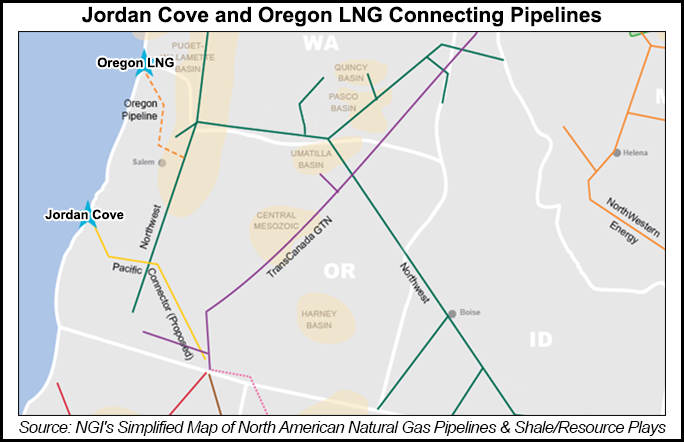Regulatory | LNG | NGI All News Access
Pacific NW Enviros Eye Regional Fossil Fuel Export Ban
The Pacific Northwest on both sides of the U.S.-Canada border, known for salmon spawning and a relatively pristine landscape, is producing something else this year — a backlash against fossil fuel export projects.

On Tuesday, a delegation of western Colorado business and energy industry representatives met in Calgary with Veresen Inc., the backer of a proposed liquefied natural gas (LNG) export project in Oregon, to reiterate their support for the project (see Daily GPI, Feb. 24).
A number of activist groups in British Columbia, Oregon and Washington would like to shut down all of the 27 different energy projects — natural gas pipelines, coal terminals, oil pipelines, and oil-by-rail projects — that dot the region in the name of sustainability and climate change mitigation.
As energy-hungry Asian nations look to the region as a launching point for North American energy supplies, groups like Seattle-based Sightline Institute, Power Past Coal, Stand Up to Oil and the Climate Action Coalition have set their sights on wiping out proposed fossil fuel exports, according to a report in the Portland Business Journal.
In Oregon, two major LNG export projects have been battling various local activist groups centered on the Columbia River and the Coos Bay area. Both have attacked proposed transmission pipelines that would connect with the LNG liquefaction facilities (see Daily GPI, May 15).
Peter Hansen, project manager for Oregon LNG’s proposed terminal at Warrenton, OR, said he is not worried about the regional opposition spreading to both sides of the international border. “There is growing recognition that U.S. foreign policy is closely linked to energy exports and that such exports are becoming increasingly important as geopolitical tools,” Hansen told NGI.
Hansen added that it is also “increasingly clear” that energy export decisions are best left to the federal government. He called the regional and local opposition to LNG and other projects the work of “radical special interest groups with poorly thought-through agendas.”
Meanwhile, developers of Western Slope natural gas reserves in Colorado reiterated their desire to move supplies to the proposed Jordan Cove project at Coos Bay. A regional delegation that included the CEO from the Grand Junction, CO, Area Chamber of Commerce, the Colorado Oil and Gas Association (COGA) and other economic development leaders from the area met with Veresen Inc. executives, whose LNG project would be a direct link for the Colorado gas supplies.
“Creating new markets for Western Slope gas reserves is a critical step toward revitalizing the regional energy economy,” said David Ludlam, who heads COGA’s West Slope Chapter. All U.S. LNG projects are important, but Jordan Cove links directly to Colorado through the Ruby Pipeline, he said.
Jordan Cove LNG CEO Elizabeth Spomer expressed support for the Colorado delegation, adding that she was pleased “to learn how important [the proposed export project] is to the communities and economies of northwest Colorado.”
Last year, Sightline Institute Policy Director Eric de Place authored a report on the region’s proposed fossil fuel exports, concluding that the facilities collectively would handle five times as much carbon as the proposed full-scale Keystone XL Pipeline. The proposed projects include seven new coal-handling terminals in BC, Oregon and Washington; two new oil pipelines, both in BC; 11 oil rail terminal projects, all but one in Washington state and the other in Oregon; and six new natural gas pipelines, two in Oregon and Washington and four in BC.
“Each of these projects is distinct, but all can be denominated in a common currency: the tons of carbon dioxide (CO2) emitted, if the fossil fuels were burned,” De Place wrote in his September 2014 report. “Taken together, these [projects] would be capable of delivering enough fuel to release 822 million metric tons of CO2 annually.”
The projected capacity on all six Pacific Northwest gas pipelines is 11.7 Bcf/d, which De Place calculated as 226.8 million metric tons of CO2, using the U.S. Energy Information Administration’s metric of 53.1 kilograms of CO2/Mcf.
© 2024 Natural Gas Intelligence. All rights reserved.
ISSN © 1532-1231 | ISSN © 2577-9877 |
